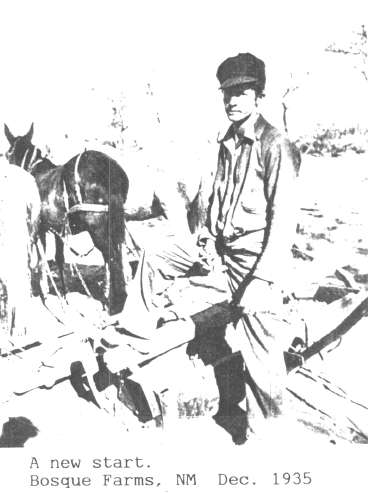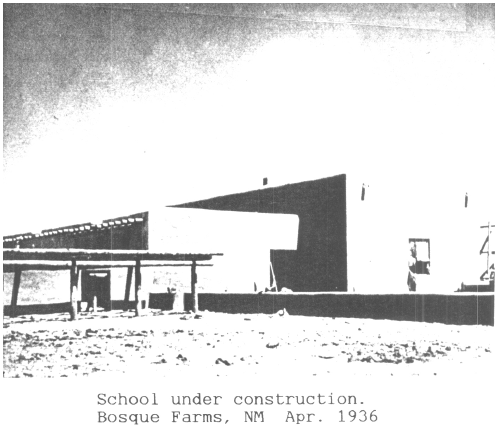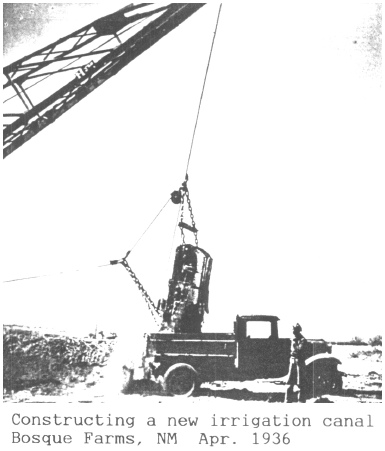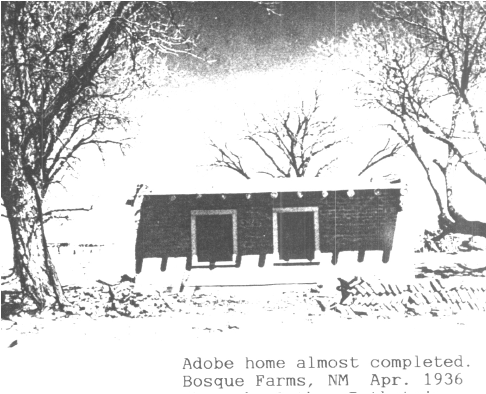Announcing the new Bosque Farms Historical Exchange Forum (pdf)
The small, rural community of Bosque Farms lies about 18 miles south of Albuquerque. Bosque Farms is situated along the braided routes of the famous Camino Real (the Royal Road) which follows the Rio Grande and provided connections among historic trading centers scattered throughout the Rio Grande valley. What is historically referred to as the Rio Abajo, or lower Rio Grande valley, has attracted settlers and traders to the region for hundreds of years.
Before the Spanish came to the Rio Abajo, Tiwa and Piros Indians roamed the area and settled in as many as five Pueblos (settlements). The nearby Isleta Indians became allies to the Spanish, who first came to the area in 1540. Bosque Farms was originally part of the Antonio Gutierrez and Joaquin Sedillo land grant in 1716. The Gutierrez and Sedillo properties were sold to Nicolas Duran de Chaves in 1736 and eventually to Clemente Gutierrez. A few years later in 1739, a flood moved the course of the river two miles to the west, and the area became known as “Bosque de Los Pinos” or “Los Pinos.”
Over the next 200 hundred years, Los Pinos (now Bosque Farms) was owned by several different people. In 1819, Francisco Xavier Chavez (Mexican Territorial Governor in 1822) purchased the land from the heirs of Clemente Gutierrez. Francisco’s son, Jose Mariano Chavez, moved to the area with his family and lived in a large hacienda that had been built by his father. Jose Mariano Chavez later died; however, his wife Dolores held on to the land and eventually was remarried to Henry Connelly, a successful businessman from Virginia. Connelly was appointed Territorial Governor of New Mexico by President Abraham Lincoln on September 4, 1861.
In the early 1860s Confederate soldiers marched up the Rio Grande Valley in the conquest of the New Mexico Territory. In February 1862, Los Pinos was occupied by Confederate soldiers. The Confederates were finally defeated at the Battle of Glorieta Pass (March 1862) and while retreating down the Rio Grande; however, the Confederates remained at the well-fortified hacienda in Los Pinos. Following a canon bombardment on April 15, the Confederates fled across the river to present-day Los Lunas. This battle, known as the Battle of Peralta, led to the deaths of three Union and four Confederate soldiers and was the last Civil War skirmish of any significance in New Mexico. A horrible sandstorm stopped the battle and gave the Confederates a chance to escape.
Governor Connelly never did reoccupy his Los Pinos estate; however, Los Pinos became a supply center for the U.S. Army’s Indian fighters. A gravel road connected the fort to the small town of Los Lemas. At Los Lemas one could ford the Rio Grande River to reach Los Lunas. Also along this road, a trading post served the area. The fort was later abandoned, the gravel road is now buried, the trading post burned, and the small town of Los Lemas has disappeared. From May to July of 1884 the Rio Grande River overflowed its banks flooding the Bosque area over the tops of the trees. (At this time and up until the WPA project, the Bosque was swamp land covered with trees). This was the worst flood in the historical record.
Religion was not forgotten in the 19th century. In the fall of 1871, the Methodist Mission work was extended to the Rio Grande Valley. A class of 42 members was organized in the Bosque-Peralta area under Ambrosia Gonzales. A year later, Reverend John Steele became the first minister. Between 1863 and 1868 Our Lady of Guadalupe, a Catholic Mission church in Peralta, was built. After over 100 years of existence, the church is still serving the Bosque-Peralta area.
In 1866, Governor Connelly died from an accidental opiate overdose, so the property was returned to his widow Dolores who lived there until her death in 1890. Following the death of Dolores, the property was owned by her son Jose Francisco Chavez, and a daughter-in-law, Francisca Romero Connelly. In 1906 Francisca Connelly sold the property to Eduardo Otero, a wealthy landowner from Los Lunas. Otero settled in the area and built a house with a large barn near the Bosque. He raised Berkshire horses, breaking them to pull loaded wagons to the Los Lunas depot.
In the 1920s, Otero sold his land in small lots to individuals, but due to the depression, which began in 1929, the people were unable to make the payments. Otero repossessed the land, and in 1934 sold 2,420 acres to the New Mexico Rural Rehabilitation Corporation. The resettlement area was eventually taken over by the Federal Resettlement Administration (part of President Franklin D. Roosevelt’s New Deal) in 1935 and named the Bosque Farms Project.
This project divided the Bosque Farms tract into 42 parcels of 40 to 80 acres in size. Forty-two families were chosen by a lottery in May 1935 and paid $140 per acre on forty-year mortgages. The Works Progress Administration (WPA) funded the drainage trenches, homes, and roads, thus beginning the community of Bosque Farms.
 Seventy-two families came from the dust bowl areas of Taos and Harding counties to the tree-covered swamps called the Bosque in 1935. Many people kept right on moving, but 42 modern pioneer families stayed to build our present Bosque Farms community. Some families lived in tents until temporary houses were built. Fourteen of the families lived together in the barn next to the old Otero ranch. The men worked in crews to build ditches to drain the swamp and clear the land of the trees. The people drew lots for their properties. 2-3 bedroom adobe homes were built by the project for the families on their lots. The loop road was called Alameda Road while the road dividing the loop in half and passing the school was named Esperanza Drive. The Bosque School was built at the same.
Seventy-two families came from the dust bowl areas of Taos and Harding counties to the tree-covered swamps called the Bosque in 1935. Many people kept right on moving, but 42 modern pioneer families stayed to build our present Bosque Farms community. Some families lived in tents until temporary houses were built. Fourteen of the families lived together in the barn next to the old Otero ranch. The men worked in crews to build ditches to drain the swamp and clear the land of the trees. The people drew lots for their properties. 2-3 bedroom adobe homes were built by the project for the families on their lots. The loop road was called Alameda Road while the road dividing the loop in half and passing the school was named Esperanza Drive. The Bosque School was built at the same.
 The citizens of Bosque Farms had to rent the land for a period of years before they could buy it. Therefore the rent had to be calculated by someone. This someone happened to be a council of five men. Bosque Farms was divided into four districts. Each district appointed a councilman. Then the whole community elected a chairman. This five-man committee calculated rent, collected it, and peacefully settled any arguments and controversies. There was a council meeting every month for about four years. In the first year, the families didn’t do too much in the way of farming. Most of them put in ditches for irrigation and worked around their homes. By 1937 most people began to farm, but Lady Luck was not with all of them. Some were lucky enough to get a crop, but many ran into alkaline soil.
The citizens of Bosque Farms had to rent the land for a period of years before they could buy it. Therefore the rent had to be calculated by someone. This someone happened to be a council of five men. Bosque Farms was divided into four districts. Each district appointed a councilman. Then the whole community elected a chairman. This five-man committee calculated rent, collected it, and peacefully settled any arguments and controversies. There was a council meeting every month for about four years. In the first year, the families didn’t do too much in the way of farming. Most of them put in ditches for irrigation and worked around their homes. By 1937 most people began to farm, but Lady Luck was not with all of them. Some were lucky enough to get a crop, but many ran into alkaline soil.
 The government then paid for complete soil testing. They tested every acre at least once and then mapped out their findings. By 1939 many people found they couldn’t make a go of farming so .they turned to dairy farms. Cas and George Jackson were among the first to switch to dairy farming and turn it into a prosperous business. Federal Security loaned the money for cows and the government built dairy barns for the families that wanted them. The completion of the drainage ditches and irrigation system by the Middle Rio Grande Conservancy District (MRGCD) in the 1930s permanently drained the marshy areas and provided, to some extent, flood protection to the valley communities. Subsequently, Bosque Farms became a well-known dairy and farming community. Dairy farming became the main agricultural industry and by the 1960s the area was referred to as the “Heart of the Rio Grande Dairy Land.”
The government then paid for complete soil testing. They tested every acre at least once and then mapped out their findings. By 1939 many people found they couldn’t make a go of farming so .they turned to dairy farms. Cas and George Jackson were among the first to switch to dairy farming and turn it into a prosperous business. Federal Security loaned the money for cows and the government built dairy barns for the families that wanted them. The completion of the drainage ditches and irrigation system by the Middle Rio Grande Conservancy District (MRGCD) in the 1930s permanently drained the marshy areas and provided, to some extent, flood protection to the valley communities. Subsequently, Bosque Farms became a well-known dairy and farming community. Dairy farming became the main agricultural industry and by the 1960s the area was referred to as the “Heart of the Rio Grande Dairy Land.”
 Over the ensuing 70 years, Bosque Farms has gradually become more residential, but still maintains a connection to its rural and farming legacy. There are still large tracks of alfalfa fields. In the past, they provided forage for dairy farms. Today, there is only one active dairy farm in Bosque Farms, and much of the alfalfa and the newer grass fields provide feed for the many horses that are part of the Bosque Farms environment.
Over the ensuing 70 years, Bosque Farms has gradually become more residential, but still maintains a connection to its rural and farming legacy. There are still large tracks of alfalfa fields. In the past, they provided forage for dairy farms. Today, there is only one active dairy farm in Bosque Farms, and much of the alfalfa and the newer grass fields provide feed for the many horses that are part of the Bosque Farms environment.
Bosque Farms was incorporated as a municipality in 1974 which enabled the community to elect its own governing body. Housing and commercial development is the primary source of revenue in the Village. However, the residents of Bosque Farms are prideful of their agricultural heritage and the associated pastoral character.